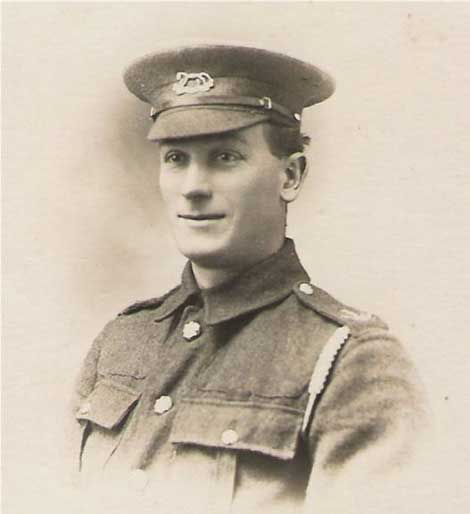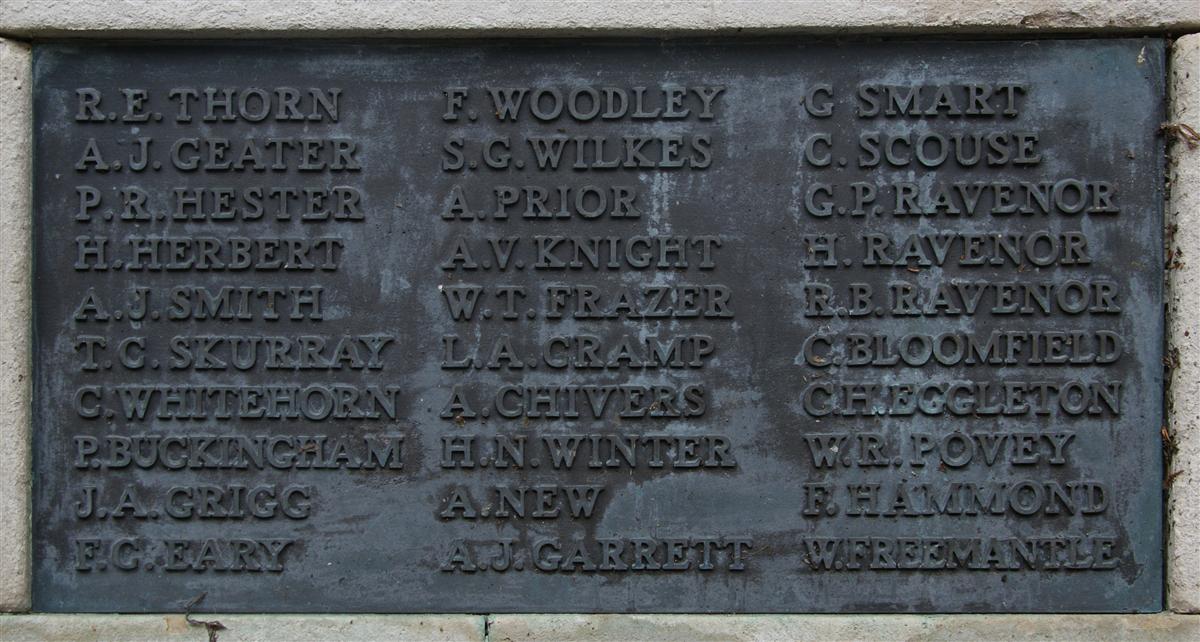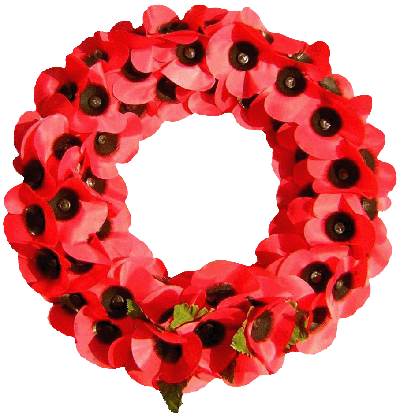Ralph Ernest Thorn
Private 203781 Ralph Ernest Thorn, 4th Battalion, Royal Berkshire Regiment.

Ralph Thorn |
Ralph was born in Newbury in 1884, the son of Thomas Thorn and his wife Mahalah née Canning. Thomas was a successful stonemason who ran his own business, first in Oxford Road, Newbury and later in Newtown Road alongside the town cemetery.
Ralph was one of seven children born to Thomas and Mahalah; one of these, the youngest, Victor Cecil, only lived a few weeks (19 October to 14 December 1902) but the rest reached adulthood. Ralph’s surviving siblings were: Daisy Beatrice (born 1880), Thomas Augustine (1882), Albert (1887), Frederick Charles (1890) and Eveline (1892).
There appears to have been something of a family conflict over Ralph’s name. His father repeatedly refers to him as Ernest or Ernest Ralph, while Ralph only ever uses Ralph or Ralph Ernest. Officially his birth was registered as Ernest Ralph and his marriage as Ralph Ernest. He will be referred to in this story as Ralph - seemingly his own preference.
After his schooling Ralph joined his father as an apprentice, learning the age-old trade of the stone mason. In 1909 Ralph married Ethel Annie East in the church of St Mary’s, East Ilsley Ethel’s home village. In 1911 they had a child, shown in their census return (2 April) as ‘baby unnamed’ aged ‘under 1 month’. The joy of the birth must have helped Ralph at a time of tragedy: his mother, Mahalah, had died only days earlier, on 19 February.
On 4 June 1911 their baby daughter was christened Marguerite Ethel. Once again they returned to East Ilsley for this family event, though they were living in Queen’s Road in Newbury (2 Fernlea). At the time of the christening Ralph gave his occupation as a monumental mason, but later that year he had taken on a new rôle as landlord of the Rokeby Arms in Newtown Road, just up the hill from his father’s house and business. Being landlord of a pub did not mean that he gave up stonemasonry, he continued to work with his father – many landlords of smaller pubs and beerhouses had daytime jobs.
Ralph was also involved in voluntary activities in the community; he was a member of the Newbury Volunteer Fire Brigade and the local company of the Berkshire Yeomanry. When war was declared in 1914 he was not among the reservists mobilised, indicating that his service with the Yeomanry was some time earlier. Many young men volunteered for the Yeomanry at the time of the Boer War; it is possible that Ralph was one such young man. However, he would not have been old enough to have joined up in time to take part in the war, which ended within a month or so of his 18th birthday.
In 1914 Ralph tried to rejoin the Berkshire Yeomanry, but was rejected on medical grounds. By the time conscription was introduced in 1916 his patriotic fervour had waned (unsurprising as the reality of this war became apparent). His father (as his employer) appealed to the local tribunal (set up the hear appeals against conscription) for Ralph's exemption from service on the grounds that he had already been rejected as unfit by the Yeomanry. However, the tribunal decided to send him for another medical:
Newbury Weekly News, 13 April 1916 - Local Tribunals - Newbury Borough
MEDICAL EXAMINATION
Mr Thomas Thorn, monumental mason, of Newtown-road, applied for the exemption of his son, Ralph Ernest, who is married. Three sons had gone into the Army, and it would be a serious hardship if the last one were called up. He had served ten years with the Berkshire Yeomanry, and when asked to rejoin he was medically examined, but was rejected. The Tribunal recommended medical examination and adjourned decision until that had been done.
Either Ralph's health had improved or standards had dropped - he was passed fit for 'General Service' ie he was fit for the trenches. Nevertheless he was granted a temporary reprieve and came before the tribunal again in August:
Newbury Weekly News, 17 August1916 - Local Tribunals - Newbury Borough
Ernest Ralph Thorn, 32, stone carver and mason, had been granted until June 30th. His father, Mr Thomas Thorn, asked for further extension, saying that his son was the only man left in the workshop. Three sons had gone on service, one of them being discharged for tuberculosis. There was no other man to do the lettering on tombstones. Major Darby-Griffiths said this man had been passed for general service and was very valuable to the Army. Thorn: They did not thinks so, because when I offered to rejoin by old regiment, the Berks Yeomanry, they rejected me as unfit. The Tribunal refused the application.
His days as a civilian were numbered - the military could now issue call-up papers, from which Ralph had no escape beyond an appeal to a higher tribunal, which would almost certainly fail.
His call up came in September 1916 when he was assigned to the Royal Berkshire Regiment. His previous military experience seems to have shortened his period in training, which would normally be six months or more following recruitment. After only three months he joined the regiment's 1st/4th Battalion in France, probably among a draft of 200+ men who arrived at the Battalion’s camp at Becourt on 22 December. This draft raised the strength of the Battalion up to 781 (at full strength there would be over 1,000 men in an infantry battalion).
Over the winter the Battalion spent periods in the trenches, but there was little action beyond the occasional raid of the enemy positions until the spring saw the allied forces advancing as the Germans withdrew to the Hindenburg Line, shortening their front and removing the need for 14 Divisions manning their lines.
Ralph’s first experience of a major offensive came on 4-6 April 1917 as the 1/4 Royal Berks, as part of the 145th Brigade, 48th (South Midland) Division, attacked and took three villages (Ronssoy, Basse Boulogne & Lempire) in an unusually successful operation. Casualties were relatively light and the Battalion left the front late on 7 April for a camp at Hamel where they would enjoy a hot meal, hot water and dry socks. Travelling at night the last of the men were in the camp by 1.25am on 8 April. Safe and sound, or so they thought, but for five of them this was not the case; a German shell landed in the camp, wounding four and killing one man – Ralph Thorn.
Ralph’s death was reported in the Newbury Weekly News on 26 April 1917:
Amongst others who will never come back from the “Great Adventure” is Private Ralph Ernest Thorn, son of Mr T. Thorn of Newtown Road, who was killed on April 7th in France. He served in the Berks Yeomanry and in the Fire Brigade, and joined up in September last, going abroad in December, taking part in some hard fighting with the Royal Berks Regiment. He was in the recent great attacks, but unfortunately was killed while resting behind the lines. A letter which Mrs Thorn has received from his officer states that “He was a good fellow, always did his best for his officers, and was well liked by his comrades. He suffered no pain whatever, being instantly killed in his sleep. A shell fell into his tent door and the shock killed him instantaneously. He was not mutilated and received a proper burial.” The letter concluded with sympathy for Mrs Thorn and family.
Postscript
When Ralph had been called up the licence of the Rokeby Arms would have been transferred to his wife, Ethel, to hold until he returned. His death meant that Ethel and the brewery had to decide whether she should continue as landlady or hand over to a long term replacement. Some widowed landladies did stick with their pubs, but Ethel was not one of them, on 4 October 1917 the Borough magistrates granted the licence of the Rokeby Arms to George Kinch.
Ethel remarried in 1921 to Christopher Luff. However, this is not quite the end of the story; in 1922, after many deliberations and arguments the town of Newbury finally settled on a site and design for their town war memorial. The design was inspired by a mediaeval stone cross in a churchyard in Cricklade, Wilts. The ornate design required some skilful carving, notably of the tabernacle that topped its 10ft 6in high column. Surmounting the shaft is a beautiful tabernacle with recessed canopies containing four figures 2ft 9in in height, and resting on the heads of angels with outstretched wings. The figures are St Michael, with wings and a balance; St George and the dragon; St Nicholas, witch a child kissing the hem of his garment, and the emblematic three balls; St Martin, represented in his clerical garb, and a goose at his side. [NWN 5 Oct 1922].
 Ralph Thorn's name on Newbury War Memorial (tablet 12) |
The masons chosen to realise this vision were Thorn & Sons. Ralph’s father Thomas (now aged 67) supervised the work himself, no doubt wanting his son to be remembered on a particularly fine memorial.
The masons chosen to realise this vision were Thorn & Sons. Ralph’s father Thomas (now aged 67) supervised the work himself, no doubt wanting his son to be remembered on a particularly fine memorial. Perhaps he even carved Ralph’s name on the stone tablets that originally held the names of the fallen (now on cast bronze replacements) – or perhaps not as the initials are R E not the E R that Thomas seems to have preferred.
His father also had one last opportunity to make his preference of name known – adding 'Ernest Ralph' to his mother’s gravestone in Newtown Road Cemetery. However, is seems that Ethel was responsible for his commemoration on the war memorials in Newbury
However, Thomas had one last opportunity to make his preference of name known – adding 'Ernest Ralph' to his mother’s gravestone in Newtown Road Cemetery. However, it seems that Ethel was responsible for his commemoration on the war memorial in her home village of East Ilsley where he is remembered as Ralph Thorn.
Brothers
The newspaper reports of Ralph’s appearances before the local Military Service Tribunal include the information that three of his brothers were serving in the armed forces, one of whom had been discharged with tuberculosis. These were Thomas, Albert and Frederick; as there is evidence that Thomas and Albert were still serving at the end of the war it must have been Frederick who was discharged with TB. As he lived a full life dying in 1960 aged 69, he must have been fortunate enough to overcome this dreadful infection that killed so many of its victims.
Thomas served with the Royal Engineers, where his skills as a stonemason may well have been of use. He enlisted on 14 October 1915 and served until his discharge on 28 March 1919, by which time he had risen to the rank of Sergeant. His discharge took place at the time when men were being discharged in their thousands his departure from the Army, but his departure was not due to the Armistice, but to the effects of a wound to his foot. He was injured by a GSW (GunShot Wound) on 22 August 1918; although this implies damage from a rifle or machine gun it is more likely that it was shrapnel from an enemy shell (shrapnel shells were packed with lead or steel balls designed to spread and inflict damage on personnel).
The wound was a severe one and, after a short period in military hospitals in France, Thomas was repatriated for treatment in Glasgow (3rd Scottish General Hospital) and then, on 12 October, to Banbury Red Cross Hospital (far more convenient for family visits). He was discharged from hospital on 10 March 1919.
Thomas returned to Newbury and the family business, taking over from his father as the head of the firm and, undoubtedly, contributing his skills to the creation of the Newbury Town War Memorial. He died in Newbury in 1945 aged 63.
Albert joined the Royal Navy on 23 October 1915 and trained as an Air Mechanic; in civilian life he had been a carpenter – a skill much needed for the maintenance of the wooden framed aircraft of the day. He served with the Royal Naval Air Service (no F8828) on HMS Nairana, a civilian ferry requisitioned by the Navy and converted for use as a seaplane carrier.
On 1 April 1918 Albert was transferred to the newly formed Royal Air Force, by which time he was a Leading Mechanic and hence became a Corporal Mechanic in the new service. He received a new service number – 208828 (evidently based on his Navy number).
Albert returned to civilian life on 9 April 1919 following a transfer to the RAF Reserve; his final discharge from the Reserve took place on 30 April 1920. He died in Newbury in 1963 aged 75.

Find a memorial :
| Died this day: | |
| 29 November 1946 | |
| L A Shears | |
| Hungerford |

Like this site? Show your appreciation through a donation to a great charity.